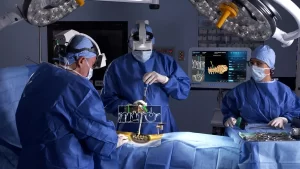Use of robotics in minimally invasive spine surgery and benefits from robotic assistance
Robotic-assisted spine surgery can perform spine fixation procedures. It can be used to treat a variety of spinal conditions, including degenerative disc disease, spinal stenosis, scoliosis, spondylolisthesis, and spinal fractures.
Robotic-assisted spine surgery
Robotic-assisted spine surgery uses a robotic arm to help the surgeon place implants with greater accuracy. It is a minimally invasive procedure that offers smaller incisions, less blood loss, reduced pain, shorter hospital stay, faster recovery time, improved accuracy, precision of implant placement, and improved outcomes.
How robotic systems are used in spine surgery
Robotic-assisted spine surgery is Minimally Invasive Surgery that offers several advantages over traditional open-spine surgery:
The robot can be programmed to perform delicate maneuvers with greater precision than a human surgeon can achieve. The robot helps surgeons place implants such as screws and rods in the spine with greater precision, which can lead to better outcomes and a reduced risk of complications, as a slight misplacement can lead to serious complications.
Robotic surgery allows surgeons to make smaller incisions than traditional surgery, which can lead to less blood loss, tissue damage, and post-surgical pain for the patient. This can result in a shorter hospital stay and faster recovery time.
The improved accuracy and minimally invasive nature of robotic surgery can help to reduce the risk of complications, such as infection, nerve damage, and bleeding. Smaller incisions from robotic-assisted surgery are associated with a lower risk of infection following surgery compared to traditional open surgery.
The robotic system can help to reduce fatigue, strain, and tremors in the surgeon’s hands, which can lead to improved focus and better outcomes for patients.
Robotics in Spine Surgery
The robotic spine surgery systems include a surgeon console, a robotic arm, and imaging guidance. An important part of robotic-assisted spine surgery is the preoperative planning process. During this process, the surgeon will use imaging studies to create a 3D model of the patient’s spine. The surgeon will use the robotic system to plan the surgery, including the placement of implants.
Surgical procedure: During the surgery, the surgeon will sit at the surgeon’s console and use the controls to manipulate the robotic arm. The robotic arm will hold the surgical instruments and make precise movements based on the surgeon’s input. The surgeon will be able to use the imaging guidance system to see the patient’s anatomy in real-time.
Post-operative care: After surgery, patients will stay in the hospital for a day or two. They will need to follow a rehabilitation program to help them recover from surgery.
What is Robotic Spine Surgery?
Spinal fusion surgery is a procedure that permanently joins two or more vertebrae together to treat a variety of spinal conditions, such as spinal deformity, instability, and pain.
Robotic-assisted spine surgery is a minimally invasive surgical technique that uses a robotic arm to assist the surgeon in performing the delicate tasks involved in spinal fusion surgery. The robot is controlled by the surgeon, who can use it to precisely place screws and rods in the spine.
Robotic-assisted spine surgery offers many advantages over traditional open spine surgery, including:
- Smaller incisions.
- Less blood loss.
- Reduced risk of infection.
- Shorter hospital stays.
- Faster recovery times.
- Improved accuracy and precision of implant placement.
Robotic-assisted spine surgery importance
- Increased Accuracy and Precision: Robotic arms are steadier than human hands, allowing for more precise placement of screws, rods, and other implants during spinal fusion surgery. This can lead to better long-term outcomes and a reduced risk of complications such as nerve damage or hardware failure.
- Minimally Invasive Approach: Robotic surgery often utilizes smaller incisions compared to traditional open surgery. This results in less muscle disruption, blood loss, and post-operative pain for the patient.
- Faster Recovery Times: Due to the minimally invasive nature, patients may experience shorter hospital stays and faster recovery times when compared to traditional open surgery. This can lead to a quicker return to daily activities.
- Reduced Risk of Infection: Smaller incisions translate to a lower risk of infection following surgery, a significant benefit for any surgical procedure.
Risks of Robotic-Assisted Spine Surgery
Higher Cost: Robotic surgery currently comes with a higher price tag compared to traditional open surgery. This includes the cost of the robotic system itself, as well as disposable surgical tools used with the robot.
Limited Availability: Robotic spine surgery is not as widely available as traditional open surgery. The technology may not be accessible at all hospitals or surgical centers.
Steeper Learning Curve: Surgeons need specialized training to operate effectively with robotic systems. While the robot is a tool, the surgeon’s skill and experience remain crucial for a successful outcome.
Not Suitable for All Cases: Robotic-assisted surgery may not be appropriate for all types of spine surgery, particularly very complex procedures or those requiring significant soft tissue manipulation.
Potential for Technical Issues: Although rare, malfunctions or technical difficulties with the robotic system can occur during surgery, potentially adding to OR time and requiring the surgeon to switch to a traditional open approach.
You can subscribe to Science Online on YouTube from this link: Science Online
You can download the application on Google Play from this link: Science Online Apps on Google Play
Robotic-assisted spine surgery importance, risks, and Is robotic spine surgery better?
Robotic Surgery vs. Laparoscopic Surgery, Robot-assisted surgery features, benefits and drawbacks
Surgical robot types, advantages, disadvantages, How is robotic surgery different from traditional
Healthcare robotics, Nursing care robots review, types, advantages, disadvantages and uses
Robot-Assisted Heart Surgery types, benefits, risks, Robotic heart vs. open-heart surgery
Interventional radiology types, Robotic endovascular systems advantages and disadvantages




